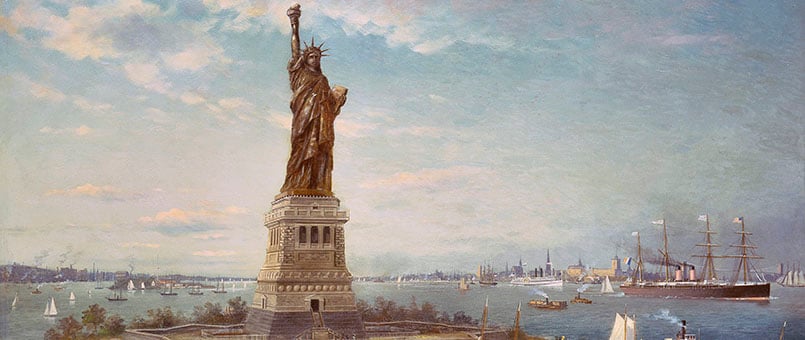
The Statue of Liberty: 130 Years
October 28th of this year marks the 130th anniversary of the day the 22nd (as well as the 24th) President of the United States Grover Cleveland dedicated the Statue of Liberty to commemorate the centennial anniversary of the signing of the Declaration of Independence.
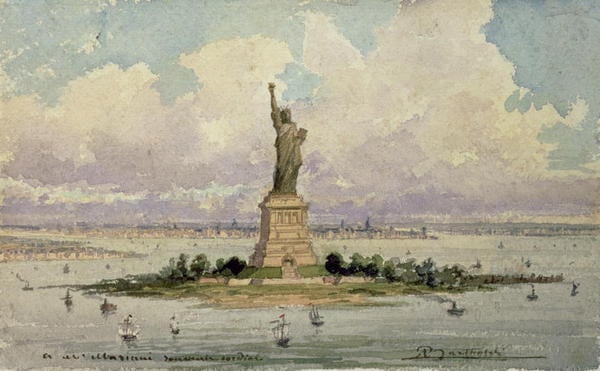
The Statue of Liberty (w/c & pencil on paper), Bartholdi, Frederic Auguste (1834-1904) / Private Collection / Photo © Christie’s ImagesHistory
“The Statue of Liberty Enlightening the World” (otherwise known simply as The Statue of Liberty), resides on Liberty Island in New York Harbor, New York City, NY. The statue was a gift of friendship to the United States of America from the people of France. Designed by French sculptor Frédéric Auguste Bartholdi and built by civil engineer Gustave Eiffle (known for building the Eiffel Tower in Paris, France). The origins for the idea of the sculpture is unknown, though many believe it was born out of a conversation between Bartholdi and Édouard René de Laboulaye (president of the French Anti-Slavery Society) in which both agreed that France should commemorate the United States for their recent achievement of abolishing slavery in the nation (hoping this gesture may inspire French citizens to question their own democracy under their oppressive monarchy).
The Statue of Liberty is of a the robed Roman goddess Libertas holding a flaming torch and a tabula ansata (translated to “a tablet evoking the law”). On this tabula ansata, Bartholdi inscribed “July 4, 1776”: the date of the American Declaration of Independence. The statue represents freedom to citizens and immigrants alike, this freedom highlighted with a broken chain at her feet.
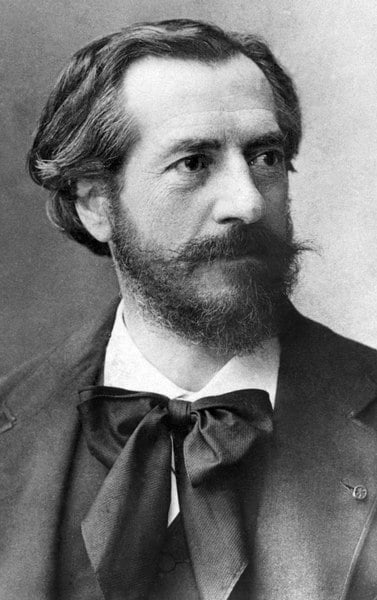
Frederic Auguste Bartholdi (1834-1904) french architect and sculptor, creator of the Statue of Liberty / Photo © PVDE
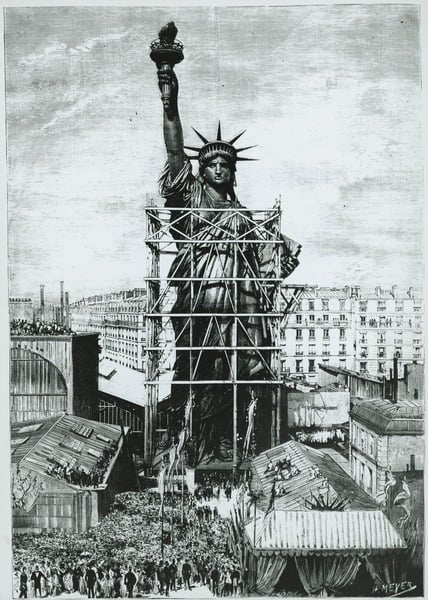
France, Paris, Giving the Statue of Liberty to United States ambassador by Henry Meyer, drawing, 1884 / De Agostini Picture Library
Construction
It took some time for both France and the United States to raise the fund required to create such a momentous statue. While France relied on public funds, a lottery, and various forms of entertainment, the United States threw benefit theatrical events, art exhibitions, prizefights, and auctions to raise the funds needed, specifically for the pedestal of the statue. It was during this tireless fundraising that Bartholdi commissioned Gustave Eiffel to assist him in the creation due to his renowned work on the famous French icon the Eiffel Tower. The two worked together to combined Eiffel’s knowledge of iron-work and Bartholdi’s ideas of a copper statue.
After years of campaigning for funds and building, the statue was officially completed in France in 1884 and arrived at New York Harbor in July of 1885. The statue remained on the island until it was finally erected and veiled on October 28, 1886 (funding for the pedestal was not completed until August 1885 and construction was not finished until April 1886). The Statue of Liberty was broken down into 350 parts when it was shipped over to the States in 214 crates. It was reassembled on top of the pedestal like a giant three-dimensional puzzle.
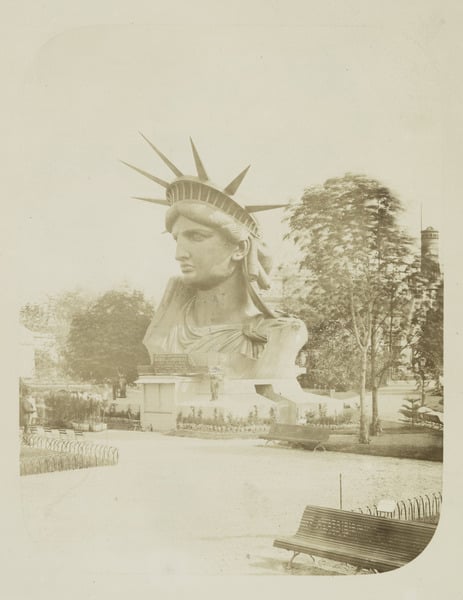
Head of the Statue of Liberty on display in a park in Paris, 1883 (albumen print) , Fernique, Albert (d.1898) / New York Public Library, USA
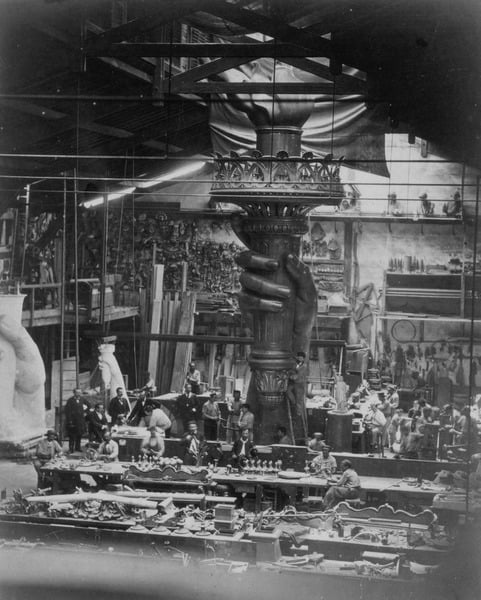
The hand of the Statue of Liberty in the Monduit workshop, 1876 (b/w photo), French Photographer, (19th century) / Private Collection / Avant-Demain
The Statue
The Statue of Liberty is one of the most recognized American national landmarks in the world. For many, it represents a new life, being the first thing that the first wave of immigrants coming to America in 1892 would see as they approached Ellis Island. It is a symbol of freedom, and it is not a small symbol.
From the base of the pedestal to the tip of the flame on the torch, the Statue of Liberty stands at 305 feet, 6 inches tall, with Lady Liberty reaching 111 feet, 6 inches from the tip of her toe to the top of her head, and she and her base weigh in at about 450,000 pounds. The torch that the Statue of Liberty holds in her hand was restored in 1986 and was covered in thin sheets of 24k gold. Upon her head, there is a crown with seven rays, representing the seven continents, symbolizing world unity.
Tourists are welcome to visit the statue and even climb up the 154 steps within the statue to the crown, where one can view outside through windows. Though originally copper, the green color of Lady Liberty is a result of the natural weathering of copper. Her copper exterior is only 0.094 inches thick, which is less than the thickness of two pennies put together.
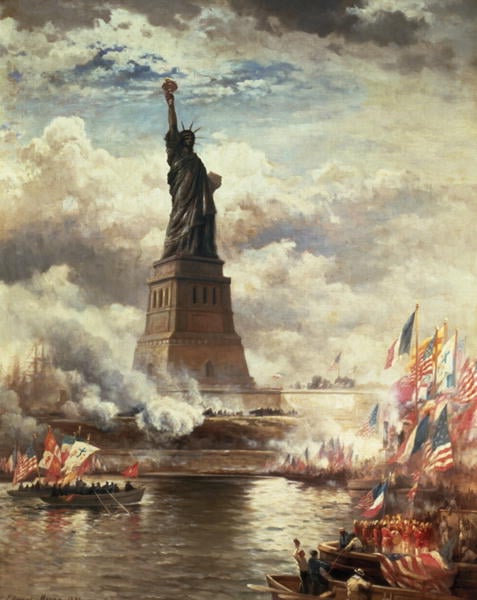
The Unveiling of the Statue of Liberty, Enlightening the World, 1886 (oil on canvas), Edward Moran (1829-1901) / Museum of the City of New York, USA
Find out More
- See more images of the Statue of Liberty in our archive
